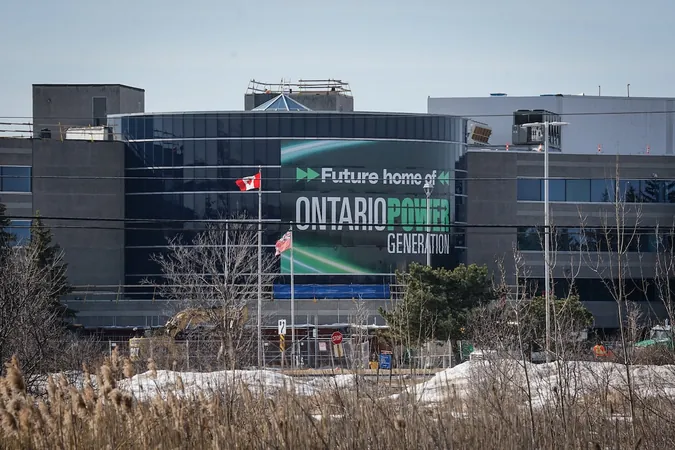
Canada Breaks Ground: First Small Modular Reactor Approved for Construction
2025-04-05
Author: Jacques
In a groundbreaking move for the nation’s energy landscape, Canada’s federal nuclear safety regulator has given the green light for the construction of a small modular reactor (SMR) at the Darlington Nuclear Generating Station in Clarington, Ontario. This pivotal moment highlights a significant step forward in Canada’s energy strategy, attracting international interest and potential investment.
The Canadian Nuclear Safety Commission (CNSC) issued the license on Friday to Ontario Power Generation (OPG) for the Darlington New Nuclear Project. OPG has announced plans to complete the first SMR—a 327-megawatt reactor—by the end of 2028, with electricity expected to flow into the provincial grid the following year. While the total cost of the project has not been publicly disclosed, estimates indicate it could reach several billion dollars.
“This license signifies a historic milestone for Ontario and Canada,” remarked OPG spokesperson Neal Kelly, as the company awaits further approval from the Ontario government to move forward.
The Darlington SMR marks a series of firsts: it will be the only nuclear reactor under construction in the Western Hemisphere and Canada’s first new reactor since the 1980s. It will also be the first BWRX-300 design to be built in any G7 country. Other jurisdictions, including Saskatchewan, the United States, Poland, and Estonia, are keen on developing their own fleets based on this innovative reactor model.
Designed by GE-Hitachi Nuclear Energy based in Wilmington, North Carolina, the BWRX-300 is a promising technology in the race toward new clean energy sources. However, increased reliance on U.S. suppliers for enriched uranium and other essentials comes at a time when Canadian-American relations are perceived to be strained. Despite this, local officials remain enthusiastic about the project. Ontario's Energy Minister, Stephen Lecce, emphasized the potential for Ontario to emerge as a stable energy superpower.
OPG initially applied for the construction license in late 2022. During public hearings, concerns were raised regarding the reactor’s design status. Although GE-Hitachi had not completed the design, OPG convinced the regulators that the design was sufficiently advanced for the CNSC to issue the license. CNSC officials noted that other countries often grant licenses even when designs are less than one-third complete.
Critics highlighted potential safety risks due to the lack of fully independent emergency shutdown systems, but CNSC staff found the risk of simultaneous failure negligible. The commission mandated that OPG provide additional documentation regarding safety protocols as construction progresses.
Recognizing the importance of Indigenous consultation, the CNSC has established several regulatory checkpoints before construction can advance. These measures are designed to ensure compliance with legal obligations to consult and accommodate Indigenous interests, particularly amid growing scrutiny of regulatory practices.
The CNSC's approval applies solely to the first SMR at Darlington. Historically, Ontario has favored a “four-packs” approach—building power plants with four identical reactors sharing infrastructure—but the move to SMRs indicates a pivotal change in strategy. Plans are already underway to develop three additional BWRX-300 units at the site.
Current developments include extensive site preparation work, with excavation depths reaching eight meters as OPG installs shared utilities such as water and sewer systems. The shift to SMRs means the new plant will produce only a fraction of the originally planned 4,800 megawatts of generating capacity, focusing instead on effective local energy solutions. Experts suggest a single BWRX-300 could adequately power a city like Markham or Vaughan.
Amidst this revolutionary project, various partners, including AtkinsRealis Group Inc. and Aecon Group Inc., are on board for the project’s delivery, with major reactor parts to be constructed by Ontario-based subcontractors like BWX Technologies. A recent Conference Board of Canada report projects that the four-reactor plant will contribute $15.3 billion to Canada’s GDP over 65 years and create around 2,000 jobs.
With calls for local businesses to be prioritized in this initiative, the Ontario government is positioning the province for a pivotal role in the evolving nuclear energy landscape. Some critics express concerns about competition amidst rising U.S. energy tariffs and regulations. However, Minister Lecce remains optimistic, stating, “We have successfully negotiated for Ontario and Canadian businesses to be at the forefront of this cutting-edge technology.”
Stay tuned as this exciting venture unfolds, potentially setting the stage for a new chapter in Canada’s energy independence and technological leadership in nuclear power.









 Brasil (PT)
Brasil (PT)
 Canada (EN)
Canada (EN)
 Chile (ES)
Chile (ES)
 Česko (CS)
Česko (CS)
 대한민국 (KO)
대한민국 (KO)
 España (ES)
España (ES)
 France (FR)
France (FR)
 Hong Kong (EN)
Hong Kong (EN)
 Italia (IT)
Italia (IT)
 日本 (JA)
日本 (JA)
 Magyarország (HU)
Magyarország (HU)
 Norge (NO)
Norge (NO)
 Polska (PL)
Polska (PL)
 Schweiz (DE)
Schweiz (DE)
 Singapore (EN)
Singapore (EN)
 Sverige (SV)
Sverige (SV)
 Suomi (FI)
Suomi (FI)
 Türkiye (TR)
Türkiye (TR)
 الإمارات العربية المتحدة (AR)
الإمارات العربية المتحدة (AR)